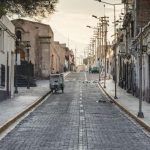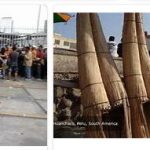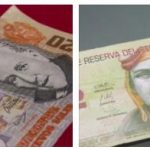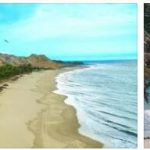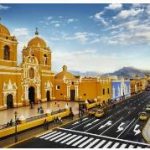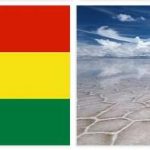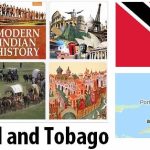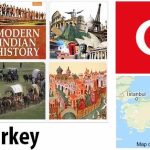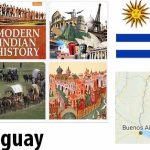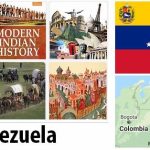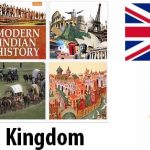Peru is a country located in South America. With the capital city of Lima, Peru has a population of 32,971,865 based on a recent census from COUNTRYAAH. The military has played a significant role in politics and for long periods has ruled Peru. The last junta was in power from 1968 to 1980 and only then did civilian rule take hold. Economic crisis and social misery helped left guerrillas take up arms in the early 1980s. During President Alberto Fujimori’s reign of 1990–2000, a major military effort was made to crush guerrillas. Fujimori was forced to resign after allegations of corruption and human rights violations, and fled the country. Democracy has since been restored.
From 1948 to 1963, the political power in Peru alternated between military junta and elected government. The period was dominated by General Manuel Odría’s dictatorship 1948–1956, when both the Left and the Liberals were persecuted with harsh methods.
- ABBREVIATIONFINDER: List of most commonly used acronyms containing Peru. Also includes historical, economical and political aspects of the country.
Exports improved, but the economic growth that followed mainly benefited the coastal area. The wide gap between “modern” Peru and the poor regions of the highlands became even more evident. Two percent of landowners controlled 70 percent of the arable land, and large areas were left unused. The move of the poor to the cities continued to a large extent. The peasants who did not leave the highlands began to resist. They organized, demanded more land and carried out strikes. Check best-medical-schools for more information about Peru.
At the same time, a middle class in the modern sense had started to emerge, and thus a new political factor. Parties demanding democratic reforms were formed. At the 1963 election, reform-friendly Fernando Belaúnde Terry, who founded the party Popular Action (AP), won. He decided to implement a land reform, but it was stopped in Parliament by conservative members and the party Apra (see Older History), which has now pushed increasingly to the right on the political scale.
Reform-friendly military junta
Discontent with the civil government grew, and in 1968 a junta under General Juan Velasco Alvarado seized power. The general, who came from simple conditions and had roots in the indigenous peoples, believed that reforms were needed to prevent popular dissatisfaction and armed resistance. Juntan carried out extensive land reform and the largest properties were handed over to employees to use in cooperative form. The regime also nationalized several foreign companies.
Reform policy soon weakened. Agricultural production developed poorly, and the gaps increased between the poorest in the countryside and the members of the cooperatives. The costly reform work contributed to both a large foreign debt and high inflation. In 1975, Velasco was replaced by more conservative militia, led by General Francisco Morales Bermúdez. He implemented an economic austerity program in collaboration with the International Monetary Fund (IMF).
With the 1980 election, democracy was reinstated and Belaúnde Terry returned to power. He pursued neoliberal policies involving the privatization of state-owned enterprises and the division of agricultural cooperatives into private entities. However, this policy could not stop the economic crisis, which was exacerbated by drought, floods and falling world market prices on the country’s export goods.
The war of the left guerrillas begins
The severe economic crisis was accompanied by a social crisis with increased child mortality, declining life expectancy and malnutrition. These conditions offered a breeding ground for two guerrilla movements. The largest, Sendero Luminoso (Shining Path), had broken out of the country’s prosperous Communist Party, and in 1980 began an armed struggle shaped by Chinese leader Mao Zedong’s revolutionary strategy. The second group, Túpac Amaru (Movimiento Revolucionario Túpac Amaru, MRTA), was formed in 1983 by some revolutionary leftist groups sympathizing with the Cuban revolution. The government was surprised by Sendero Luminoso’s tactics and terrorist actions, and responded with fierce anti-terrorist combating. The army’s actions affected many civilians and forced others to join the guerrillas.
The indigenous peoples’ traditional cultivation of coca had by this time developed into an extensive cocaine trade and smuggling to the United States and Europe. In 1978, cocaine cultivation was prohibited if it were to be processed into cocaine. The ban was unpopular with the farmers and Sendero Luminoso took advantage of the situation. By the mid-1980s, armed guerrillas had established themselves in parts of the Huallaga Valley, where most of the cook is grown. The guerrillas protected the farmers and they levied a “tax” on the drug traffickers from Colombia who controlled the smuggling. Through this “business”, Sendero Luminoso became perhaps the world’s most wealthy guerrilla group at the time.
Apra, who now described herself as a Social Democrat, and its leader Alan García Pérez won in the 1985 elections. President García’s economic policies gave consumers increased purchasing power through increased wages, price hikes and subsidies. In 1987, he announced that the private banks would be nationalized, sparking fierce protests. A protest movement arose under the leadership of author Mario Vargas Llosa (see also Culture). The government’s economic policy led to hyperinflation and large deficits in central government finances. Inflation was exacerbated by the large amount of black money circulating in the country due to drug trafficking.
Alberto Fujimori to power
Before the 1990 elections, Alan García’s popularity had reached a bottom level. It was widely expected that Presidential candidate Vargas Llosa would prevail, but the election was won by the almost unknown Alberto Fujimori, who with his Change 90 movement represented something new. His simple background and Japanese ancestry allowed the indigenous people to identify with him, while Vargas Llosa was associated with the traditional upper class.
Contrary to what he said in the election campaign, Fujimori introduced tougher financial austerity than suggested by both the right and the IMF, the so-called Fuji shock. Controlled prices were released and government spending was reduced by shrinking social programs. The exchange rate of the country’s currency was written down. The Fuji shock resulted in, among other things, half a million government employees losing their jobs and at sharply rising food prices. But at the same time, the policy meant that the hyperinflation that prevailed in 1990, over 7,500 percent, had decreased to 57 percent in 1992.
Fujimori’s policy initially received support from Congress, but the contradictions grew gradually. Among other things, the politicians wanted to stop proposals for stricter anti-terror laws. After securing military support, Fujimori carried out a constitutional coup in April 1992. He repealed the constitution and dissolved Parliament. The members of the Supreme Court were dismissed, opposition politicians and journalists were imprisoned. After international pressure, at the end of the year an assembly was elected to write a new constitution. The new constitution was approved in a referendum in the autumn of 1993.
Fujimori had given the armed forces and the police basically free hands in the fight against guerrillas. In the fall of 1992, the military seized most of the leaders of Sendero Luminoso, including the founder of the movement Abimael Guzmán. In 1993, several leading members of the guerrilla Túpac Amaru were also arrested. This group gained the most attention when it occupied the Japanese ambassador’s residence in 1996 and took over 500 people hostage. The military’s fierce pursuit of guerrillas also affected many civilians.
In the 1995 presidential election, Fujimori won by just over 64 percent of the vote. His main challenger was the former UN Secretary General, Javier Pérez de Cuéllar. Fujimori’s victory was based on the fact that the economy had again improved and that the fight against the guerrillas had been successful. In the congressional elections, Fujimori’s party gained absolute majority over a divided opposition.
Peru’s international relations had initially improved during Fujimori’s early years as president, but after a while the criticism of the lack of democracy and human rights violations grew.
Abuse and corruption
In 1995, the president passed a criticized law that provided amnesty for all human rights violations by the military since 1980. Fujimori’s close relations with the army became increasingly troublesome when new disclosures about the military’s involvement in the cocaine trade came in 1996. Suspicions were also directed at Presidential Adviser Vladimiro Montesinos, who was head of the National Intelligence Service (SIN).
Sendero Luminoso, who suffered defeat not only against the military but also against self-defense groups in the countryside, was increasingly weakened and in 1999 Guzmán’s successor in the leadership post, Óscar Ramírez, was arrested. Thereafter, the guerrillas were mainly regarded as defeated.
Fujimori had forged a resolution in Congress in 1996 that allowed him to be elected a third time, which violated the Constitution. Prior to the April 2000 presidential election, several corruption deals had been revealed, and the economy had deteriorated. The official election result gave Fujimori close to 50 percent, while a relatively unknown economist with the indigenous people, Alejandro Toledo, gained just over 40 percent. Thus Fujimori did not gain a majority, despite reports of widespread electoral fraud. Toledo refused to participate in the second round of elections. It still took place and the voice counters gave Fujimori just over 51 percent.
Only a few months later, a scandal was revealed that became Fujimori’s case. In September 2000, a TV channel aired a tape recording showing how security chief Montesinos bribed a member of parliament to transfer him to Fujimori’s Alliance Perú in 2000. Later, hundreds of similar videotapes that Montesinos saved for holding hooks on politicians, judges, TV managers and others who have received bribes. The vice president resigned and Montesinos went underground. Fujimori fled to Japan, where in November he announced by fax that he had left his post.
Congress President Valentin Paniagua formed an interim government. Attempts to get Japan to extradite Fujimori were unsuccessful as they gained Japanese citizenship. Vladimiro Montesinos was extradited from Venezuela in 2001, and he was indicted on approximately 60 counts, including corruption, bribery, drug and weapons smuggling and murder.
A Truth and Reconciliation Commission formed to investigate events during the guerrilla war submitted its report in 2003. Over 69,000 people, most of whom belonged to indigenous peoples in the Andes villages, were estimated to have been killed in the violence between the guerrillas and the military in the years 1980-2000. About 6,000 others were missing. Nearly a third had fallen victim to the security forces. Sendero Luminoso was charged with systematic methods of terror against civilians, while army soldiers and police were charged with other abuses.
Problems for President Toledo
Extensive work on restoring democracy awaited the fall of the Fujimori regime. In the 2001 presidential election, Alejandro Toledo won 53 percent of the vote. The main opponent was former president Alan García.
Even after six months, Toledo’s popularity among the public had dropped sharply. The impatience was great after the election promises of more jobs and the fight against poverty. Although the economy gradually improved, Toledo’s whole time as president came to be characterized by popular protests and strikes, inability to resolve various crises, many ministerial changes and a series of scandals.
The last year of the Toledo government was marked by worsening social contradictions. In three regions in the northwest, the peasant population formed self-defense groups and carried out violent protests against the foreign mining companies that exploited the copper and gold deposits in the area. The companies were accused of causing water shortages, poisoning land and water and destroying agricultural land. In Puno and other regions in the south-east, disturbances occurred both among the Aymara and Quechua people. To this was added a continuing security threat from the remains of Sendero Luminoso. According to the government, there were still 200–300 guerrilla members on the loose, mainly in the province of Huallaga where the trade in boiling continued to a large extent.
García back in power
Alan García returned to power in the 2006 election despite being unpopular during his previous reign during the 1980s. García now assured voters that he had learned from past mistakes. The opponent was a contentious political newcomer and former Colonel Ollanta Humala Tasso. Humala was supported mainly by the poor indigenous people in the highlands. He was suspected of abuse during his time as a military and was also viewed with mistrust by certain groups because of the support he received during the election campaign of Venezuela’s left-wing president Hugo Chávez. A short time after the election, Humala was brought to justice, accused of human rights violations during the fight against leftist guerrillas in the early 1990s. He was released in 2009 for lack of evidence.
García’s popularity dwindled after his entry. The president was criticized, among other things, in connection with the conclusion of a free trade agreement with the US in 2008. He then tried to simplify for foreign oil and gas companies to exploit land owned by indigenous peoples. Violent protests broke out in several provinces. The bill was finally voted down by Congress. An investigation revealed that several members of the government received bribes from foreign oil companies in exchange for contracts, which led to García dismissing the entire government in 2008.
The following year, new violent protests broke out, resulting in the deaths of dozens of people, both civilians and police. Criticism against the government grew and several ministers were allowed to resign.
Fujimori extradited and imprisoned
In April 2009, the verdict fell against former President Alberto Fujimori who was extradited from Chile where he took refuge in 2007. Fujimori was sentenced to 25 years in prison for corruption, abuse of power and human rights violations in the 1990s.
In the spring of 2010, new concerns arose about the control of mineral resources. Now it was the gold washer in Arequipa in southern Peru who objected to plans to limit the right of individuals to wash gold. The government said it wanted to protect the environment and reduce social problems and economic crime.
In the first round of the 2011 presidential election, Ollanta Humala and Alberto Fujimori’s daughter Keiko Fujimori received the most votes. The result meant that the second round was between two disputed candidates from each end of the political spectrum.
Humala becomes president
Humala in the electoral movement tried to distance himself from Hugo Chávez and instead tried to position himself closer to the more moderate left-wing government in Brazil, thereby also attracting middle voters. When the election was held in June, Humala departed with the victory, with three percentage points more votes than Fujimori.
Despite his election message of ending poverty and social exclusion, Humala essentially came to watch over the market economy system. Growth in Peru remained relatively robust while social conflicts remained a cause for concern.
After his entry, Humala signed a law that gave associations of indigenous peoples the right to have a say in the team in connection with the exploitation of their traditional lands. The law meant that companies must seek agreement with local residents regarding projects that affect the landscape. However, the residents did not get veto rights. It also took over a year and a half before the law could be applied for the first time. One monkey was that there were no guidelines as to what requirements an organization should meet in order to be considered a “association of indigenous people”.
Humala also promised to crush the last remains of Sendero Luminoso that were still active, albeit on a small scale. Cooperation with the cocoa growers and the profitable drug trade had come to dominate the group’s activities. In February 2012, the government also saw great success when the guerrilla leader in Huallagadalen was arrested. Even those who tried to replace the arrested leader ended up behind locks and booms. Subsequently, there were mainly guerrilla members in a valley southeast of Lima, called Vraem, where cooks are grown (see Agriculture and Fisheries). In August 2013, three leaders were killed for Sendero Luminoso in Vraem and throughout the year a far larger area of illegal cultivation was destroyed than in previous years.
government Restructuring operations
Cooperation within the government did not run smoothly and already in December 2011, Humala was forced to implement its first government reform since Prime Minister Salomón Lerner chose to resign. Coalition partner A possible Peru (PP) left the government. As a result, the government lost its majority in Congress. Interior Minister Oscar Valdés became new prime minister but resigned after only six months after criticizing his stubborn attitude about a controversial mining project and in social conflicts.
The successor Juan Jiménez launched a “dialogue process” and invited the opposition to talks. Jiménez sat longer than the two representatives, but in October 2013 it was his turn to go. He was strongly criticized by both the media and the opposition. The nail in the coffin for him as head of government may have been a statement that people were “hysterical” about the security situation in Peru. Jiménez was supposed to pull down the already low opinion figures of the Humala government.
Jiménez’s successor César Villanueva was received with cautious optimism but after only four months at his post, Villanueva also got his foot. He resigned after failing to overcome widespread criticism of a decision by the government to raise ministerial salaries. Villanueva was replaced by Housing Minister René Cornejo. In addition to Villanueva, seven other ministers were replaced, and Now Possible Peru returned to the government.
But in the summer of 2014, Humala carried out yet another refurbishment in the government and replaced several heavy ministers. New Chief Minister now became former Labor Minister Ana Jara (see Calendar). The Confiep business organization applauded the new appointments, while the left flank within Humala’s support troops was less satisfied.
Declining popularity
After the arrest of Sendeo Luminoso’s leader in the Huallaga Valley in early 2012, almost 60 percent of Peruvians thought Humala did a good job. But then his popularity declined. Humala, who went to elections with radical promises, instead pursued a cautious economic policy that was appreciated by the middle class and the country’s business interests. But this, coupled with the government’s inability to fulfill several promises of social reforms, diminished the support of the president of rural poor people. He also ended up on a collision course with the country’s trade union body because of an initiative that was aimed at eliminating incompetent and low-performing officials in the state apparatus.

